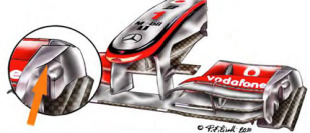- GP Week
Technical Update: Spanish GP

The return of F1 in Europe coincided with the Spanish Grand Prix and, as usual, this race brought a huge array of technical changes to the cars.
The first four flyways races prevented the teams from introducing significant changes on their cars, even if, as we saw, the development was still going on. The most heavily evolved car on the grid in Spain was the Mercedes W01. The car had a visually striking new air intake and engine cover and, a slightly less obvious but just as important, longer wheelbase - created by moving the front suspension forward by about 10cm. This was done to find a better weight distribution and improve, not just the overall performance of the car, but also the use of the tyres.
Among the other interesting evolutions, McLaren introduced a deeply revised front wing, and other ancillaries related to the car's floor. Red Bull also introduced a heavily revised version of its undertray, especially in the area in front of the rear wheels, sporting an horizontal slit to better feed the rear diffuser section of the car.
The changes in detail
The Mercedes changes are visually striking due to the new engine air intake, pushed rearwards compared to the previous version, and lowered. The engine air intake is now made up of two separate sections, divided by the roll structure that is now in the shape of a vertical fin to divide the airflow and provide a better, cleaner airflow to the rear wing. This helps to provide a cleaner and more effective airflow to the sort of 'minimal' F-duct system placed within the rear wing's main profile. The F-duct now receives less turbulence and works better than it did with the more cumbersome engine cover used at the start of the season.
As mentioned before, the other change featured on the Mercedes cars was the increase of the wheelbase, achieved by pushing forward the front axle. This change is only slightly visible, thanks to the different angle of the steering link, visible from above. Previously it was inclined slightly rearwards but now it is perfectly perpendicular to the car's longitudinal centreline.

Red Bull, on the other hand, introduced changes that were not so easily seen. The horizontal section of the undertray in front of the rear wheels features a deeper and wider slit, which is designed to better feed the rear diffuser and maximise the downforce generated by the bottom of the car. In doing so, Red Bull can reduce the angle of its rear wing, cut drag and gain top speed on the straight. This is best seen as a sort of counter attack by Red Bull to the fashionable F-duct.

